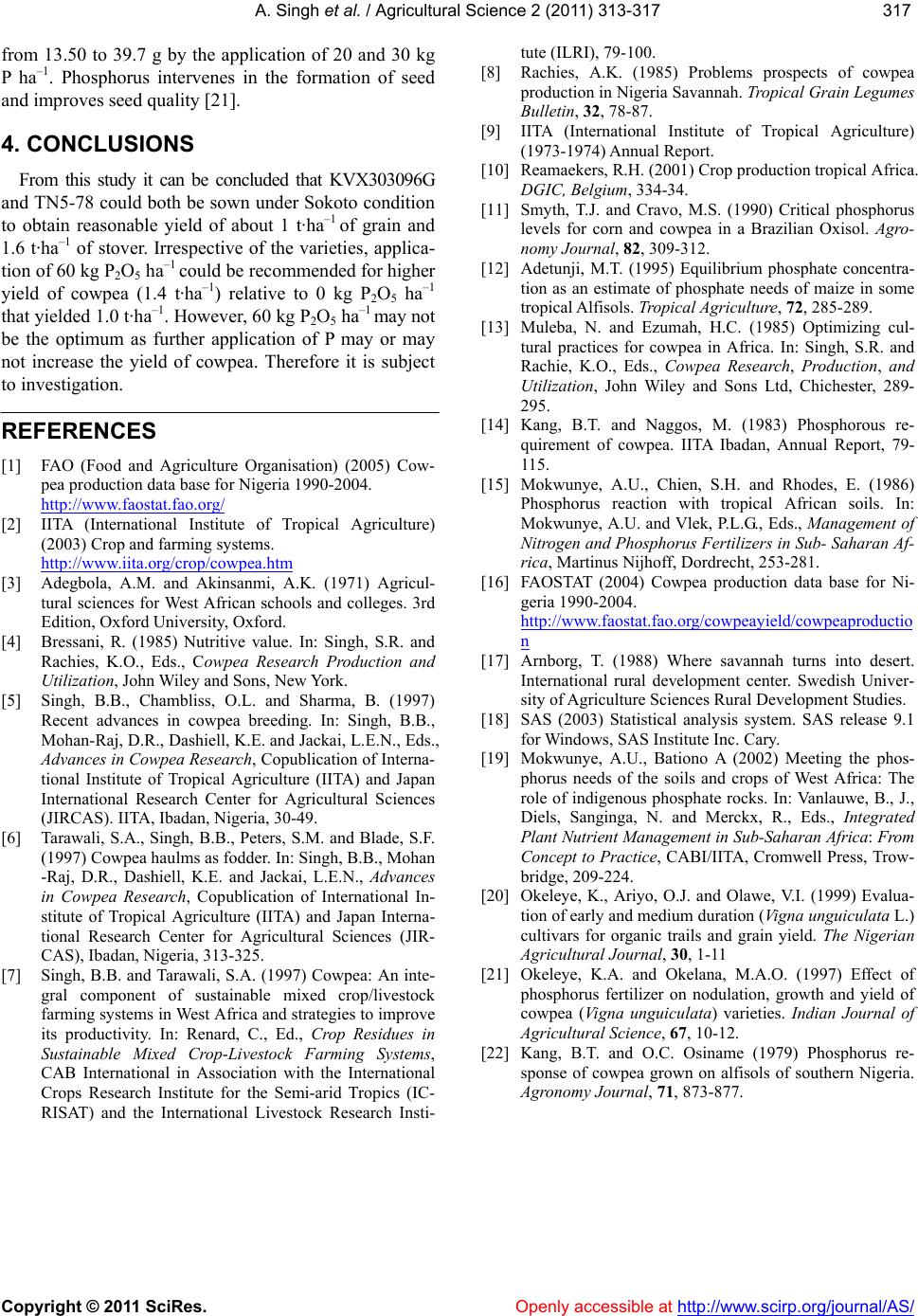
A. Singh et al. / Agricultural Science 2 (2011) 313-317
Copyright © 2011 SciRes. http://www.scirp.org/journal/AS/
317317
from 13.50 to 39.7 g by the application of 20 and 30 kg
P ha–1. Phosphorus intervenes in the formation of seed
and improves seed quality [21].
Openly accessible at
4. CONCLUSIONS
From this study it can be concluded that KVX303096G
and TN5-78 could both be sown under Sokoto condition
to obtain reasonable yield of about 1 t·ha–1 of grain and
1.6 t·ha–1 of stover. Irrespective of the varieties, applica-
tion of 60 kg P2O5 ha–1 could be recommended for higher
yield of cowpea (1.4 t·ha–1) relative to 0 kg P2O5 ha–1
that yielded 1.0 t·ha–1. However, 60 kg P2O5 ha–1 may not
be the optimum as further application of P may or may
not increase the yield of cowpea. Therefore it is subject
to investigation.
REFERENCES
[1] FAO (Food and Agriculture Organisation) (2005) Cow-
pea production data base for Nigeria 1990-2004.
http://www.faostat.fao.org/
[2] IITA (International Institute of Tropical Agriculture)
(2003) Crop and farming systems.
http://www.iita.org/crop/cowpea.htm
[3] Adegbola, A.M. and Akinsanmi, A.K. (1971) Agricul-
tural sciences for West African schools and colleges. 3rd
Edition, Oxford University, Oxford.
[4] Bressani, R. (1985) Nutritive value. In: Singh, S.R. and
Rachies, K.O., Eds., Cowpea Research Production and
Utilization, John Wiley and Sons, New York.
[5] Singh, B.B., Chambliss, O.L. and Sharma, B. (1997)
Recent advances in cowpea breeding. In: Singh, B.B.,
Mohan-Raj, D.R., Dashiell, K.E. and Jackai, L.E.N., Eds.,
Advances in Cowpea Research, Copublication of Interna-
tional Institute of Tropical Agriculture (IITA) and Japan
International Research Center for Agricultural Sciences
(JIRCAS). IITA, Ibadan, Nigeria, 30-49.
[6] Tarawali, S.A., Singh, B.B., Peters, S.M. and Blade, S.F.
(1997) Cowpea haulms as fodder. In: Singh, B.B., Mohan
-Raj, D.R., Dashiell, K.E. and Jackai, L.E.N., Advances
in Cowpea Research, Copublication of International In-
stitute of Tropical Agriculture (IITA) and Japan Interna-
tional Research Center for Agricultural Sciences (JIR-
CAS), Ibadan, Nigeria, 313-325.
[7] Singh, B.B. and Tarawali, S.A. (1997) Cowpea: An inte-
gral component of sustainable mixed crop/livestock
farming systems in West Africa and strategies to improve
its productivity. In: Renard, C., Ed., Crop Residues in
Sustainable Mixed Crop-Livestock Farming Systems,
CAB International in Association with the International
Crops Research Institute for the Semi-arid Tropics (IC-
RISAT) and the International Livestock Research Insti-
tute (ILRI), 79-100.
[8] Rachies, A.K. (1985) Problems prospects of cowpea
production in Nigeria Savannah. Tropical Grain Legumes
Bulletin, 32, 78-87.
[9] IITA (International Institute of Tropical Agriculture)
(1973-1974) Annual Report.
[10] Reamaekers, R.H. (2001) Crop production tropical Africa.
DGIC, Belgium, 334-34.
[11] Smyth, T.J. and Cravo, M.S. (1990) Critical phosphorus
levels for corn and cowpea in a Brazilian Oxisol. Agro-
nomy Journal, 82, 309-312.
[12] Adetunji, M.T. (1995) Equilibrium phosphate concentra-
tion as an estimate of phosphate needs of maize in some
tropical Alfisols. Tropical Agriculture, 72, 285-289.
[13] Muleba, N. and Ezumah, H.C. (1985) Optimizing cul-
tural practices for cowpea in Africa. In: Singh, S.R. and
Rachie, K.O., Eds., Cowpea Research, Production, and
Utilization, John Wiley and Sons Ltd, Chichester, 289-
295.
[14] Kang, B.T. and Naggos, M. (1983) Phosphorous re-
quirement of cowpea. IITA Ibadan, Annual Report, 79-
115.
[15] Mokwunye, A.U., Chien, S.H. and Rhodes, E. (1986)
Phosphorus reaction with tropical African soils. In:
Mokwunye, A.U. and Vlek, P.L.G., Eds., Management of
Nitrogen and Phosphorus Fertilizers in Sub- Saharan Af-
rica, Martinus Nijhoff, Dordrecht, 253-281.
[16] FAOSTAT (2004) Cowpea production data base for Ni-
geria 1990-2004.
http://www.faostat.fao.org/cowpeayield/cowpeaproductio
n
[17] Arnborg, T. (1988) Where savannah turns into desert.
International rural development center. Swedish Univer-
sity of Agriculture Sciences Rural Development Studies.
[18] SAS (2003) Statistical analysis system. SAS release 9.1
for Windows, SAS Institute Inc. Cary.
[19] Mokwunye, A.U., Bationo A (2002) Meeting the phos-
phorus needs of the soils and crops of West Africa: The
role of indigenous phosphate rocks. In: Vanlauwe, B., J.,
Diels, Sanginga, N. and Merckx, R., Eds., Integrated
Plant Nutrient Management in Sub-Saharan Africa: From
Concept to Practice, CABI/IITA, Cromwell Press, Trow-
bridge, 209-224.
[20] Okeleye, K., Ariyo, O.J. and Olawe, V.I. (1999) Evalua-
tion of early and medium duration (Vigna unguiculata L.)
cultivars for organic trails and grain yield. The Nigerian
Agricultural Journal, 30, 1-11
[21] Okeleye, K.A. and Okelana, M.A.O. (1997) Effect of
phosphorus fertilizer on nodulation, growth and yield of
cowpea (Vigna unguiculata) varieties. Indian Journal of
Agricultural Science, 67, 10-12.
[22] Kang, B.T. and O.C. Osiname (1979) Phosphorus re-
sponse of cowpea grown on alfisols of southern Nigeria.
Agronomy Journal, 71, 873-877.